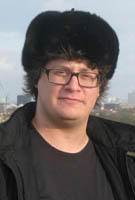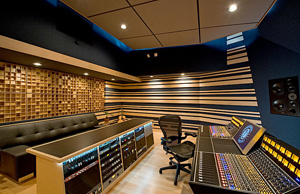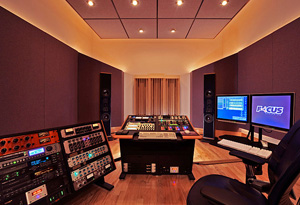Marc Alan Goodman’s Building Strange Weather Blog – Step Two: Design!
Second in the “Building Strange Weather Blog” series by producer/engineer and studio owner Marc Alan Goodman. Click to read Part I.
WILLIAMSBURG, BROOKLYN: Since I opened the first Strange Weather, I’ve considered myself an amateur acoustical designer. I’ve always had to look at the space available to me and figure out how to best use it, and the new studio started no differently.
The first thing I did was pull out all of my studio design books and re-read them. I highly recommend both Home Recording Studio: Build it Like the Pros by Rod Gervais and the older but still accurate Building a Recording Studio by Jeff Cooper.
Now, for the first time in my life, I’m working with a completely blank space, a rectangular frame in which I can do anything I want, which presents me with a completely different list of problems and questions. In the past I’ve only had to worry about things such as “How do I beef up the sound reduction of this wall?” or “Where do I place the console to get the most even reflections?”
Now those questions have become secondary to “Where should the walls go?”and “How will the electrical and HVAC systems work?”
INTELLIGENT DIY DESIGN: LEARNING WHAT YOU CAN AND CANNOT DO YOURSELF
As in the past, I decided the best way to learn is to do, so I opened up Google SketchUp (a free AutoCAD program, which I highly recommend toying around in even if only for fun) and started laying out the space. I made myself a simple shell and moved the rooms around in various ways, always trying to find what the problems were with each subsequent design.
After I’d gone through a few and the problems became less obvious I headed to a few online studio design forums to get some outside advice.
It’s unbelievable to me the community of people who spend their time online talking about just designing studios. Almost all of the main recording forums have flourishing studio design sections, and there are a few where it is the only topic.
The one with the most technical replies consistently turned out to be the John L. Sayers Recording Studio Design Forum. John is in his own right an internationally-known studio designer and he hosts a forum where not only he but a number of other well-known designers regularly mingle with home studio owners.
It only took two real postings for me to realize I was going to need some help.
People were helpful if a little harsh in their commentary (like all web forums there’s still a good amount of unrestrained argumentativeness) and I felt like my designs were being torn apart. It took a day or two for me to realize that it wasn’t a personal affront. I am not a professionally trained architect or studio designer — of course I don’t know what I’m doing. I realized that it would take years for me to accumulate the additional knowledge I would need to design this space well.
Armed with that trinket of information I went back to the bottom line: my budget. The only thing more expensive than building a recording studio is rebuilding one.
In previous spaces I’ve run up against the issue very clearly. If I build a wall, and it doesn’t do what I expected it to do, I have to tear it down and build another wall. And it costs me twice as much. Since all of my spaces have been temporary it hasn’t been a significant problem, but the whole game changes in a permanent space. If I build it right the first time I should never have to change it. And now understanding how little I really know about design, I decided that a greater part of my budget should be put towards architects and engineers.
I can paint, I can hang drywall, I can even learn simple plumbing and improve my framing techniques, but I’m never going to learn a lifetimes worth of design in that same period of time.
FINDING A STUDIO DESIGNER
So where does one look to find studio designers? There were a bunch of names I already knew like George Augspurger and John Storyk, having heard their names a thousand times, as well as Rod Gervais from his book and John L. Sayers from his forum. I’d heard a number of Augsperger and Storyk rooms but before contacting them to find out about costs, I discovered a designer named Wes Lachot.
Wes is from North Carolina and started out as a recording engineer and musician. He’s been running Overdub Lane Studio in Durham NC for years but at some point branched out into studio design. Since then he’s built rooms for Mitch Easter, Mike Mogis (Saddle Creek Records) and Doug Van Sloun, and designed the completely ridiculous carbon-neutral uber-studio soon to open in North Carolina, Manifold Recording.
Looking at photos of his designs and speaking to a number of people who’ve worked with him online, my interest was definitely piqued, and I decided the only logical thing to do next was go listen to one of his rooms.
By a strange coincidence the room he had most recently completed was Charleston Sound just outside Charleston, SC. One of my best friends in the world had moved down there and I hadn’t had an opportunity to visit her yet, so I hopped on my 72 Beemer and rode down in a day. (As a side note I don’t recommend spending 14 straight hours on a motorcycle. I love long rides but it was a little much for even me.)
Wes and his wife Lisa who runs the company with him (along with their one employee, draftsman Rob Warren) were down in South Carolina for an annual visit to the Frank Lloyd Wright house. We all met up at Charleston Sound and I got an opportunity to walk through it with Wes, hear about his ideology and his reasoning in designing the place, and give the control and live rooms a serious listen.
I was floored.
Wes is a proponent of the RFZ (Reflection Free Zone) school of control room design. This means building control rooms where the reflections are absolutely minimized at the listening position.
While the ideas behind this aren’t new, the technology has improved dramatically in the last few decades. But what I heard when sitting at the console wasn’t any of the technological data. It was simple and beautiful sonic balance. We skimmed through a couple records and to this day I can’t believe how deeply I could hear into what was going on.
But that’s not the only thing that sold me. The real trick was when I went to sit down on the couch.
As every engineer knows, the sound on the couch — usually in the back of the control room — traditionally sounds pretty damn different from at the console. I find myself constantly reminding clients that when they’re giving a serious listen, they should pull chairs up to the front of the room. But sitting on the couch at Charleston Sound was an entirely different story.
I won’t claim it sounded exactly like the sweet spot, but it was so close as to be almost indistinguishable, and it was definitely a significant improvement over even the sweet spot of any control room in which I can remember working. Right there I made my decision, but I tried to hold my cards back to see how much it was going to end up costing me.
Over lunch Wes and I realized we have very similar outlooks on what a recording studio is, should be, and what life inside one should be like. I just folded right there and told him he was designing the new Strange Weather.
WAIT, I NEED ANOTHER ARCHITECT?
Now it was time to go through the whole thing again, but in another direction. While certainly competent enough, Wes is not a licensed Architect in New York State. So I was going to need a second architect to go over the plans for any local specifics and to submit them for permits due to it being a commercial space.
On top of that, since the building contains more than just the studio, I needed another architect to help design the apartment for the second floor.
It all fell into place relatively easy. I got in contact with a few friends looking for recommendations, and my friend (and great musician) Sam Barron put me in contact with Hannah Purdy.
Hannah’s designs fit perfectly into my aesthetic for the apartment, plus she was extremely excited about getting to work on a recording studio and learn more about the specifics of soundproofing and acoustical design.
ROUNDING OUT THE CREW…
So now there was only one piece of the design puzzle left. We still needed a licensed engineer to deal with structural issues in the building (soundproofing weighs a lot!), as well as to finalize the HVAC and electrical systems.
Again I got lucky and Hannah suggested I get in contact with Bruce Merdjan at Brooklyn-based Advanced Professional Engineering. Not only does the man know everything about his profession but he also rides a 90’s BMW bike. Maybe it’s not the most obvious selling point in the world, but you really do have to get along with the people you’re working closely with.
TIME TO GET TO WORK!
That’s the team I’m working with, and how and why I selected them. Obviously the case may be totally different for anyone else but I couldn’t recommend any of these people more highly.
Next entry we’ll start getting into the oh-so-fun world of New York City building permits, as well as the realities of having become a landlord. As always please feel free to write with any questions you may have!
Marc Alan Goodman
strangeweathersound at gmail dot com
http://strangeweatherbrooklyn.com
Marc Alan Goodman is a producer/engineer who’s worked with artists such as Jolie Holland, Marc Ribot Shudder to Think, Dub Trio, Normal Love, Alfonso Velez, Angel Deradoorian and Pink Skull.











Andy Hong
September 2, 2010 at 5:06 pm (14 years ago)Congrats on connecting with Wes. (Hi Wes!) Looking forward to further installments of this series!
Andy Hong
September 2, 2010 at 10:06 am (14 years ago)Congrats on connecting with Wes. (Hi Wes!) Looking forward to further installments of this series!
Jon Nolan
September 3, 2010 at 3:12 am (14 years ago)marc!
so this is the blog you were writing when i called? too funny. cant wait to hear more about yer journey. i’ll prolly harass you for more info again sometime! ha.
cheers,
Jon
Jon Nolan
September 2, 2010 at 8:12 pm (14 years ago)marc!
so this is the blog you were writing when i called? too funny. cant wait to hear more about yer journey. i’ll prolly harass you for more info again sometime! ha.
cheers,
Jon
Randy Gildersleeve
September 21, 2010 at 6:40 am (14 years ago)Really good blog Marc! As a long time studio owner in the midwest, I can relate to many of the things you are saying. Best of success on the build of your new place.